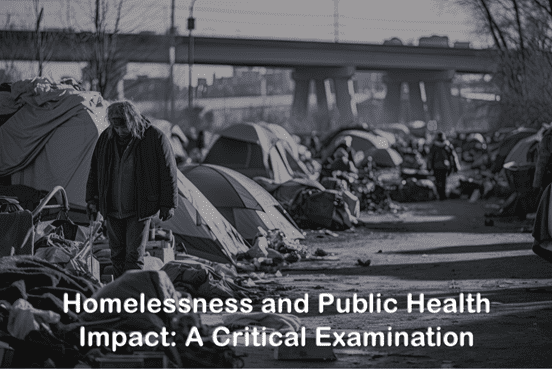
Homelessness and Public Health Impact: A Critical Examination
Homelessness is not merely a housing crisis; it is a public health crisis. On any given night, hundreds of thousands of people in the United States find themselves without stable shelter (CDC, 2023). These individuals may be chronically homeless, temporarily displaced, fleeing domestic violence, or grappling with various other issues. Homelessness is closely linked to declines in both physical and mental health being they are most vulnerable to the “tri- morbidity of social marginalization: mental illness, addiction, and physical illness (Gicas, et al., 2020). Homeless individuals experience disproportionately high rates of health problems, including HIV infection, substance abuse, mental illness, and tuberculosis (Sleet & Francescutti, 2021). These health challenges stem from a complex interplay of factors such as barriers to care, lack of access to adequate food and protection, and limited social services.
The Impact of Homelessness on Health
- Risk Exposure: Homeless individuals face heightened risks due to exposure to harsh weather conditions, violence, and unsanitary living conditions. Their vulnerability to infectious diseases is significantly increased.
- Mental Health: The stress of homelessness exacerbates mental health issues. Depression, anxiety, and post-traumatic stress disorder are prevalent among this population.
- Substance Abuse: Substance abuse is rampant among homeless individuals. Lack of stable housing contributes to a cycle of addiction and exacerbates health problems.
- Chronic Illnesses: Homelessness complicates the management of chronic illnesses such as diabetes, hypertension, and asthma. Access to consistent medical care is limited.
Mortality Rate of Homeless in California
Cal Matters published an article in February 2024 examining a study published in Health Affairs researching mortality rates of homelessness over a period of about ten years and comparing the age expectancy of homeless and the national average life expectancy. In the study’s finding, from 2011 to 2020, mortality rates increase 238% and when comparing average life expectancy of homeless to the U.S. national average, on average, those who are homeless die on average at age 51 while the U.S. national average is around 78 years old (Kendall, 2024).
Legal and Policy Approaches
- Criminalization: Some jurisdictions criminalize homelessness, imposing fines or penalties for sleeping in public spaces. However, this punitive approach fails to address the underlying health issues.
- Housing First: Evidence supports the “Housing First” model, which prioritizes providing stable housing to homeless individuals. This approach recognizes that housing is a fundamental determinant of health.
- Healthcare Access: Policies should focus on improving healthcare access for homeless populations. Mobile clinics, outreach programs, and mental health services are essential.
Criminal Justice and Homelessness
Is being homeless illegal in California? Technically, yes. There are various laws that make activities homeless people do illegal. Such laws include loitering, illegal camping, and panhandling. These laws are put in place for neighborhood aesthetics and public safety. Yet, these laws also bring controversy as they target the homeless population who have no means for shelter or source of income other than panhandling. Tents that provide shelter for vagrants do not provide adequate protection from the outside elements and they need to survive with limited resources. For example, during the winter or when temperatures are cold, the homeless tend to create a fire for warmth. Unfortunately, these fires can get out of control causing unintended destruction of property. In 2017, at a homeless camp in Los Angeles, an illegal cooking fire sparked by a homeless person causing the destruction of six home and 422 acres of land.
Since many homeless inject illegal drugs such as heroine, there is a risk of sharing used needles that can spread diseases like Hepatitis and HIV. In order to reduce the spread of such diseases, a syringe service program (SSP) was developed to provide clean needles; this program has shown success in reducing the spread of diseases caused by the injecting with used needles (Des Jarlais, Feelemyer, LaKosky, Szymanowski, & Arasteh, 2019). However, the SSP causes another public health problem as the homeless tend to not dispose of their needles properly. In San Francisco, the increase in homeless also create an increase in waste such as human feces, trash and used needles (Rephelson, 2018).
There is controversy regarding clearing out homeless encampments displacing homeless; however, there is also a public health risk having these encampments in the neighborhoods. In San Diego and Portland; there were reports of a Hepatitis outbreak spreading and infected those providing service to the homeless.
Conclusion
Addressing homelessness requires a holistic approach that considers health, housing, and social services. In addition, it requires collaborative efforts from mental health professionals, policymakers, and communities. By understanding the primary and secondary impact of homelessness on public health, we can develop effective interventions and policies to improve the well-being of vulnerable individuals, and by recognizing homelessness as a public health crisis, we can work toward effective solutions that benefit both individuals and communities.
Works Cited
CDC. (2023, March 6). Homelessness as a Public Health Law Issue: Selected Resources. Retrieved from Centers for Disease Control and Prevention: https://www.cdc.gov/phlp/publications/topic/resources/resources-homelessness.html
Des Jarlais, D. C., Feelemyer, J., LaKosky, P., Szymanowski, K., & Arasteh, K. (2019). Expansion of Syringe Service Programs in the United States, 2015–2018. American journal of Public Health, 988-991.
Gicas, K. M., Jonea, A. A., Thornton, A. E., Petersson, A., Livingston, E., Waclawik, K., . . . Honer, W. G. (2020). Cognitive decline and mortality in a community-based sample of homeless and precariously housed adults: 9-year prospective study. BJPsych Open, 6(2), e21, 1-8.
Kendall, M. (2024, February 29). It’s now significantly more deadly to be homeless. Why are so many people dying? Retrieved from Cal Maters: https://calmatters.org/housing/homelessness/2024/02/homeless-mortality-report/
Rephelson, S. (2018, August 1). San Francisco Squalor: City Streets Strewn With Trash, Needles And Human Feces. Retrieved from NPR: https://www.npr.org/2018/08/01/634626538/san-francisco-squalor-city-streets-strewn-with-trash-needles-and-human-feces
Sleet, D. A., & Francescutti, L. H. (2021). Homelessness and Public Health: A Focus on Strategies and Solutions. International Journal of Environmental Research and Public Health, 11660.


